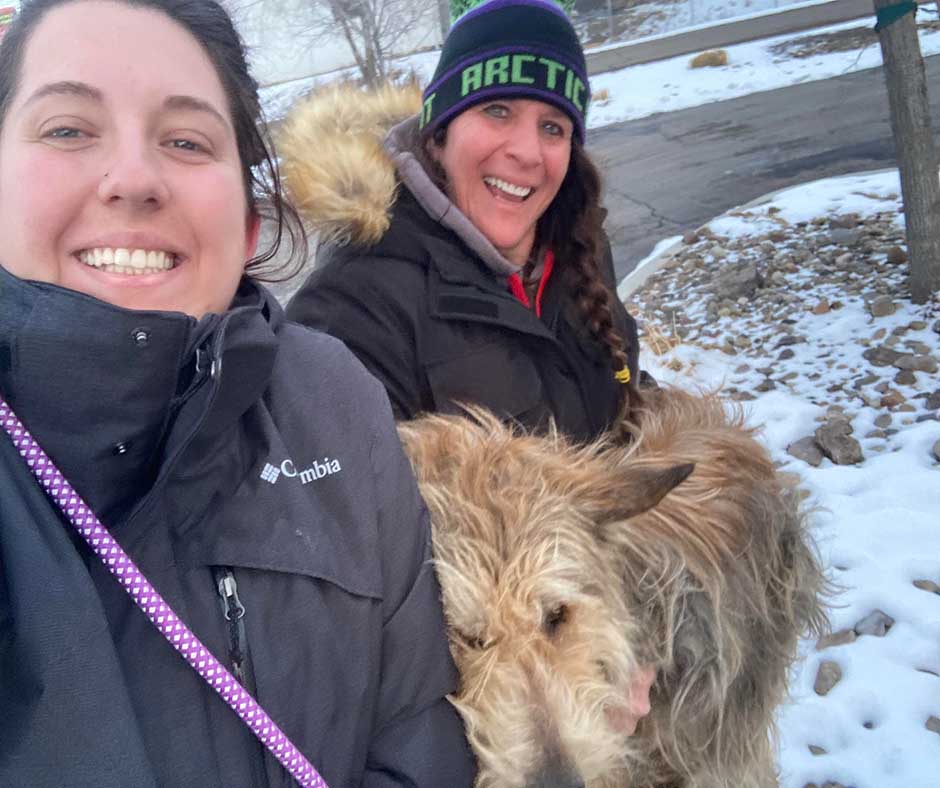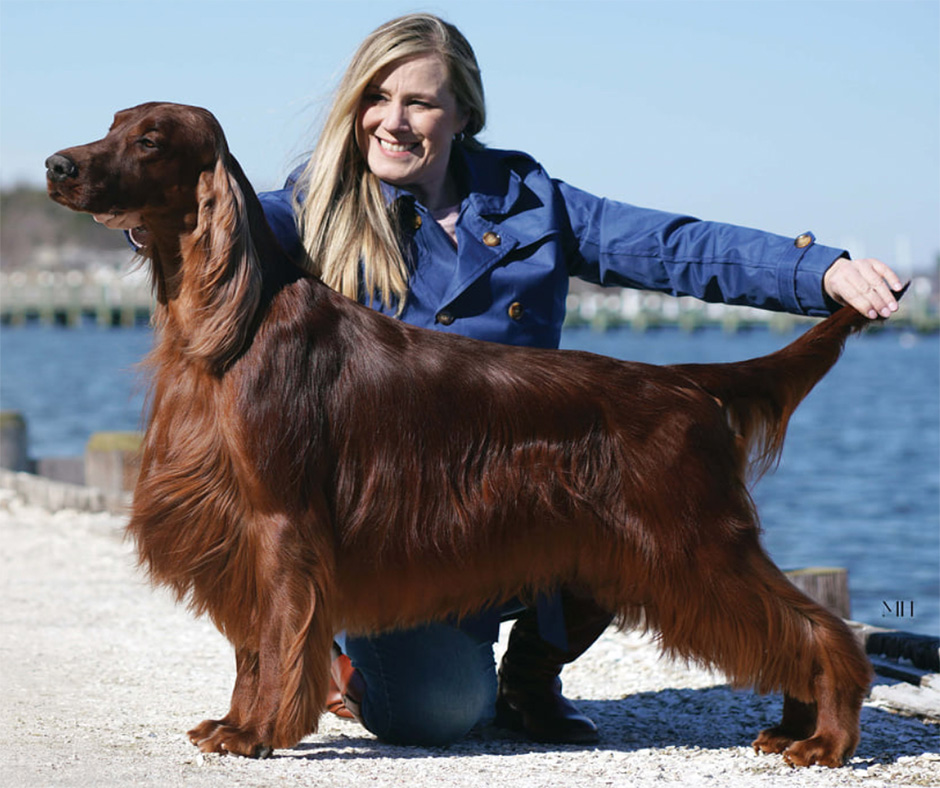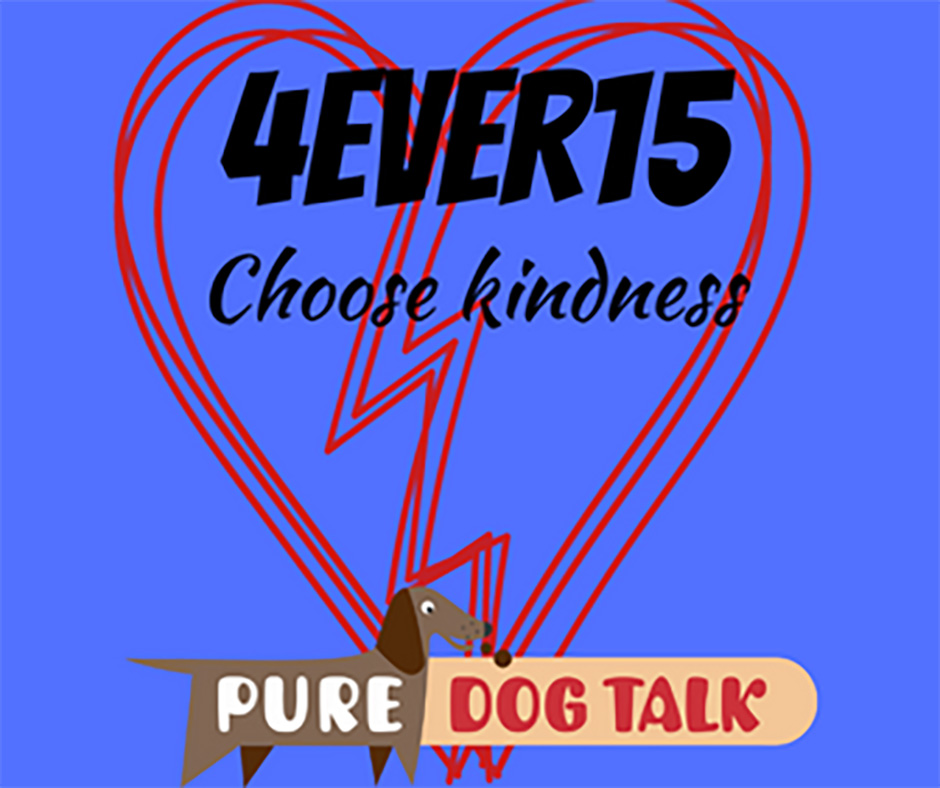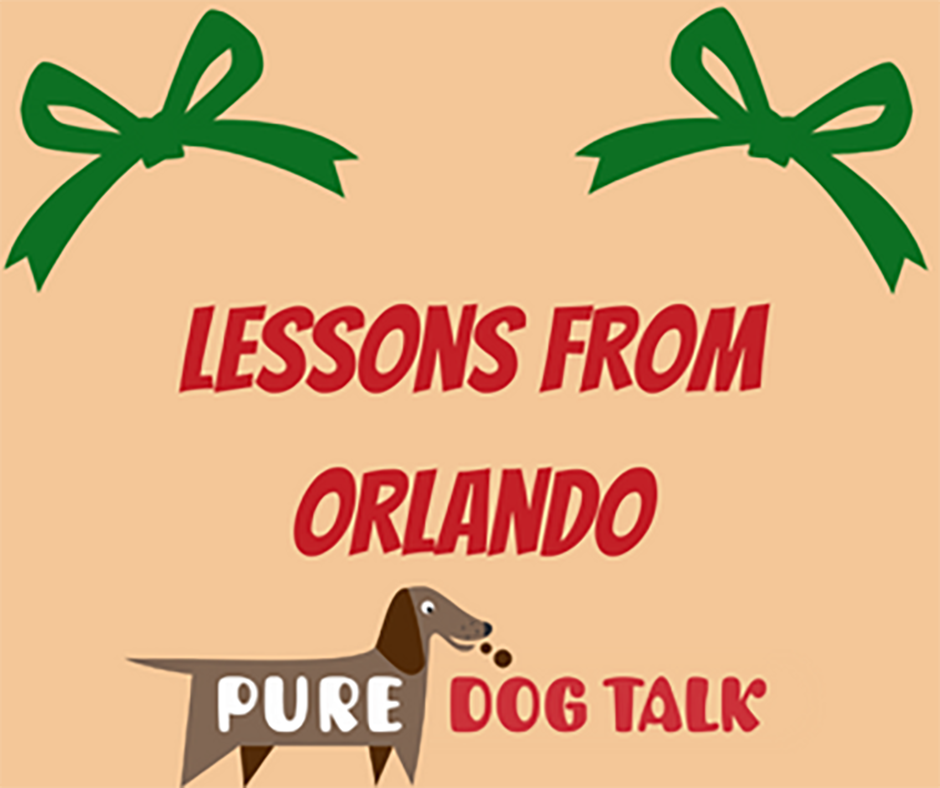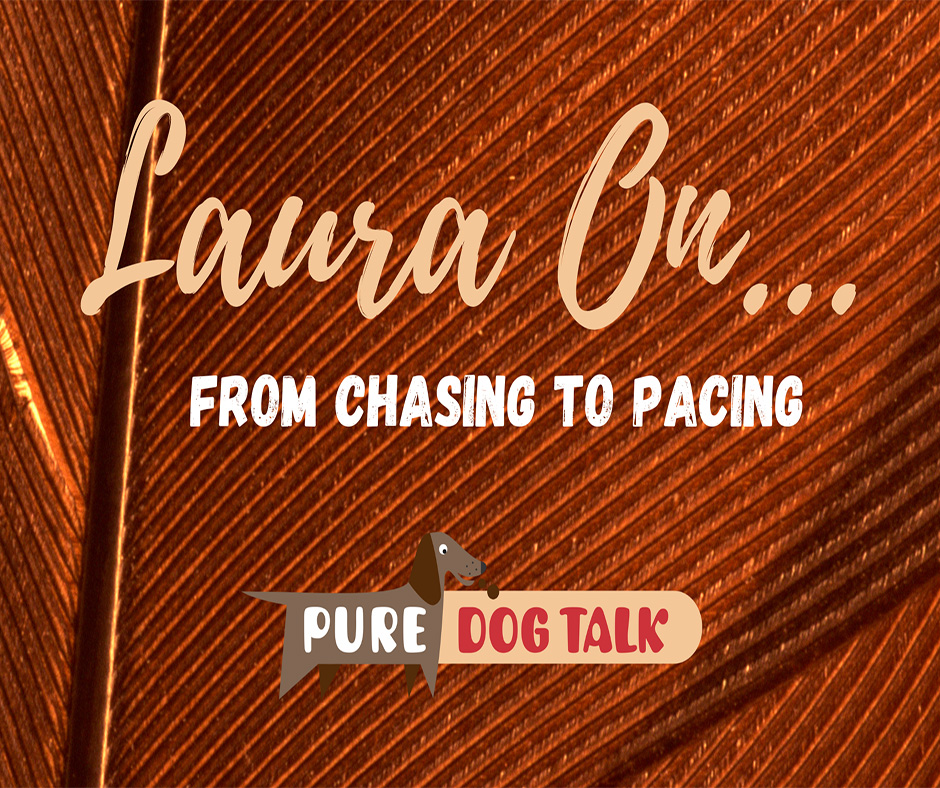566 – Routines Create Coping Skills in Traumatic Times
Routines Create Coping Skills in Traumatic Times

Dr. Angel Iscovich, MD, author of “The Art of Routine”
Dr. Angel L. Iscovich, M.D. joins host Laura Reeves to talk about creating routines as a coping mechanism in traumatic times. An emergency room physician and Miniature Schnauzer enthusiast, Iscovich’s book “The Art of Routine” has great suggestions as we emerge from the trauma of the pandemic years.
Iscovich studied older patients and found that consistently, folks who lived well into their older years had one thing in common. Routines. Even routines that aren’t necessarily “healthy” were beneficial, Isocvich noted.
“I noticed people that were over 100 years of age, centenarians, I noticed two qualities that they had,” Iscovich said. “One is that they have a stable environment. By that I mean both physical and people around them. And two, they had a very, very regular routine. They had a rhythm, a routine, things that they did with great regularity.
“But what I also noticed is what they did varied quite a bit. So, some of them were doing not necessarily healthy things, but that got me to thinking. That may be part of the key is more the *how* than the *what* we’re doing. In other words, the routine may be more important than actually what you’re eating because here’s this 100-year-old having Dr. Peppers every day, you know, and that doesn’t seem like the right thing to do, but that there was something to the fact that you had routine and regularity.
“It seemed to me that for us as humans in this world where we’re using our digital world as we are today in computers and sort, that we’re being constantly interrupted and disrupted and being always tempted to do different things all the time, and that maybe, maybe changing things up too much is not really the way to go.
“We seek and survive by having kind of stability. Homeostasis is what it’s called in some of the physiological terms. And having equilibrium.”
Iscovich’s suggestions for building routine for a healthier outcome:
- Recreate your own routine
- Get more exercise
- Get outdoors
- Do daily affirmations
- Quiet time … get rid of the sensory input
- Self discipline… dopamine works. Do one event, do it repetitively, complete the smallest task. This makes the body and brain chemistry give you a good feeling. Stick with one thing. This stabilizes us in times of uncertainty
565 – Bumble’s Story: Behind the Scenes with Donna Beadle
Bumble’s Story: Behind the Scenes with Donna Beadle
Donna Beadle joins host Laura Reeves to share the epic, joyous and eventually tragic story of Bumble the Berger Picard.
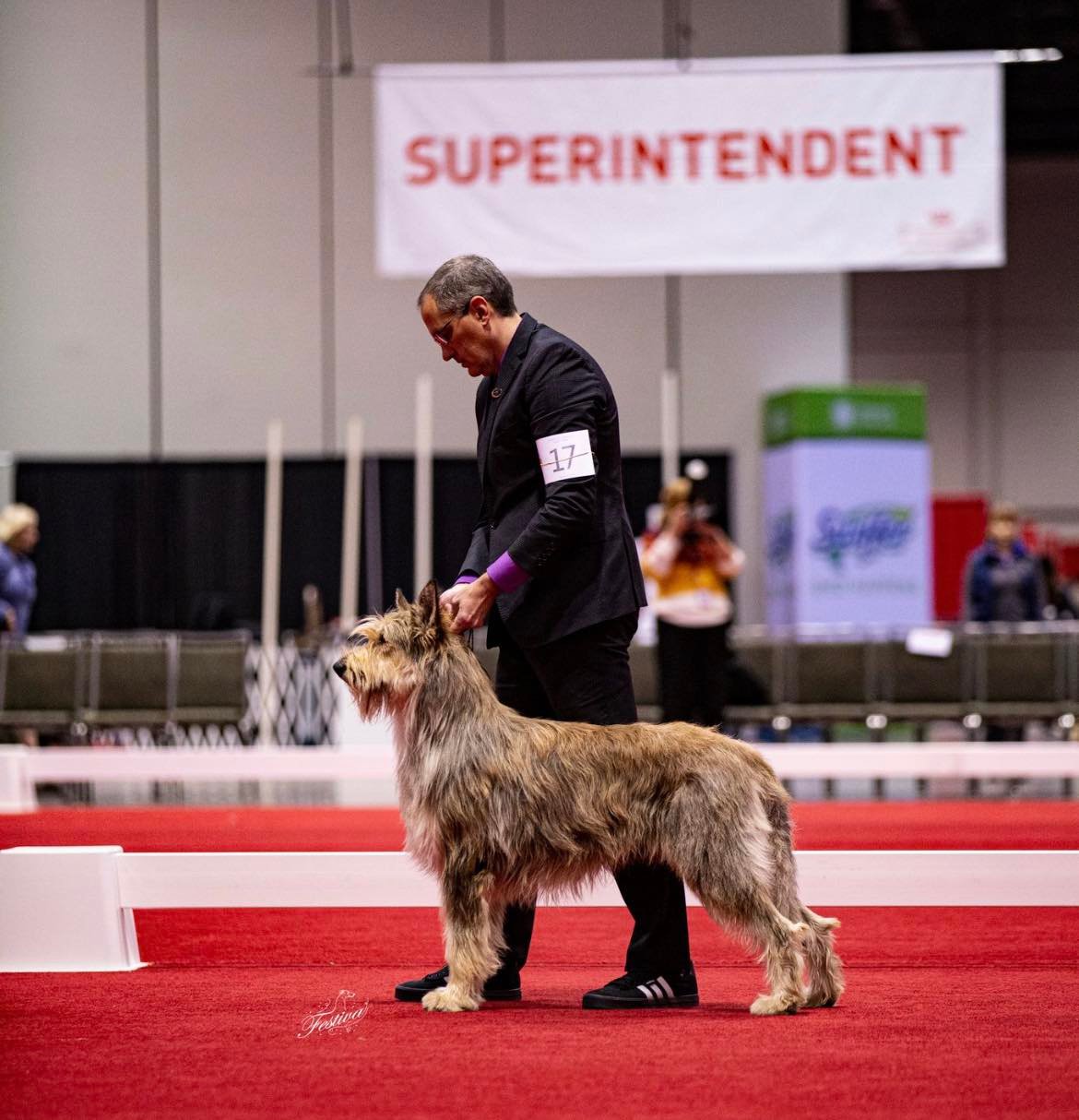
Bumble, in his glory days as the #1 Owner Handled Berger Picard, with Donna’s husband, Mike Beadle.
Bumble was lost for 10 days in the high desert of Wells, Nevada. Donna shares the lessons she learned, the emotions, the hardships, the dark humor, the kindness of strangers as well as her heartache, hope and second guessing, tips and suggestions for others in similar situations.
“If you are looking for a lost pet, especially in an area you don’t know, hire a professional,” Donna said. “They are a wealth of information. I know a lot about dogs, but I don’t know anything about lost dogs. They came they brought their trap, advised me about getting stuff out in the community. Not everybody is on social media, lost dog signs are hugely important.
“There were sightings on and around I80, which was terrifying, but that’s where we were focusing our efforts. I had to drive that interstate every day looking for my dog’s body…”
Donna traveled from Minnesota to Nevada at the first news of Bumble’s loss. She and a team of trackers, trappers, local residents, co-owners and dog community spent almost a week hunting for Bumble. After losing hope with no sightings and the tracker hitting a dead end on the trail, she returned home.

Juan, the ranch worker who first sighted Bumble, gave up his day off to help on the search and was instrumental in Bumble’s reunion with Donna.
A sighting by a ranch worker the next day brought her flying back for three more days of searching in a new area.
“Why signage and flyers are so important, the ranch owner and the ranch worker’s daughter both called because Juan saw ‘the dog in the picture,’” Donna said.
More traps, trappers and local folks restarted the search a mile back on the ranch land.
It was like looking for a needle in a haystack
Strapped into unfamiliar snowshoes, Donna traipsed through sagebrush and waist-high snow drifts in an area that they’d found new tracks in the snow. Juan, the ranch worker, came out on his day off to help with the search.
By a miracle, Donna glanced up to see her dog huddled under a small sagebrush.
Donna said, “OMG, I’ve stumbled upon Bumble.”
She was able to get a hand on him through a careful approach. He was so weak she had to carry him out. While a bodybuilder, Donna isn’t accustomed to the 6000+-foot elevation of the high desert and struggled through snow drifts until a vehicle was able to reach them.
Bumble was raced to the veterinarian, and given emergency treatment, care, and love. The extreme stress on his body caused him to crash four days later and, tragically, he couldn’t fight any longer.
564 – Owner Handler Winner: “These Dogs Are Worthy”
Owner Handler Winner: “These Dogs Are Worthy”
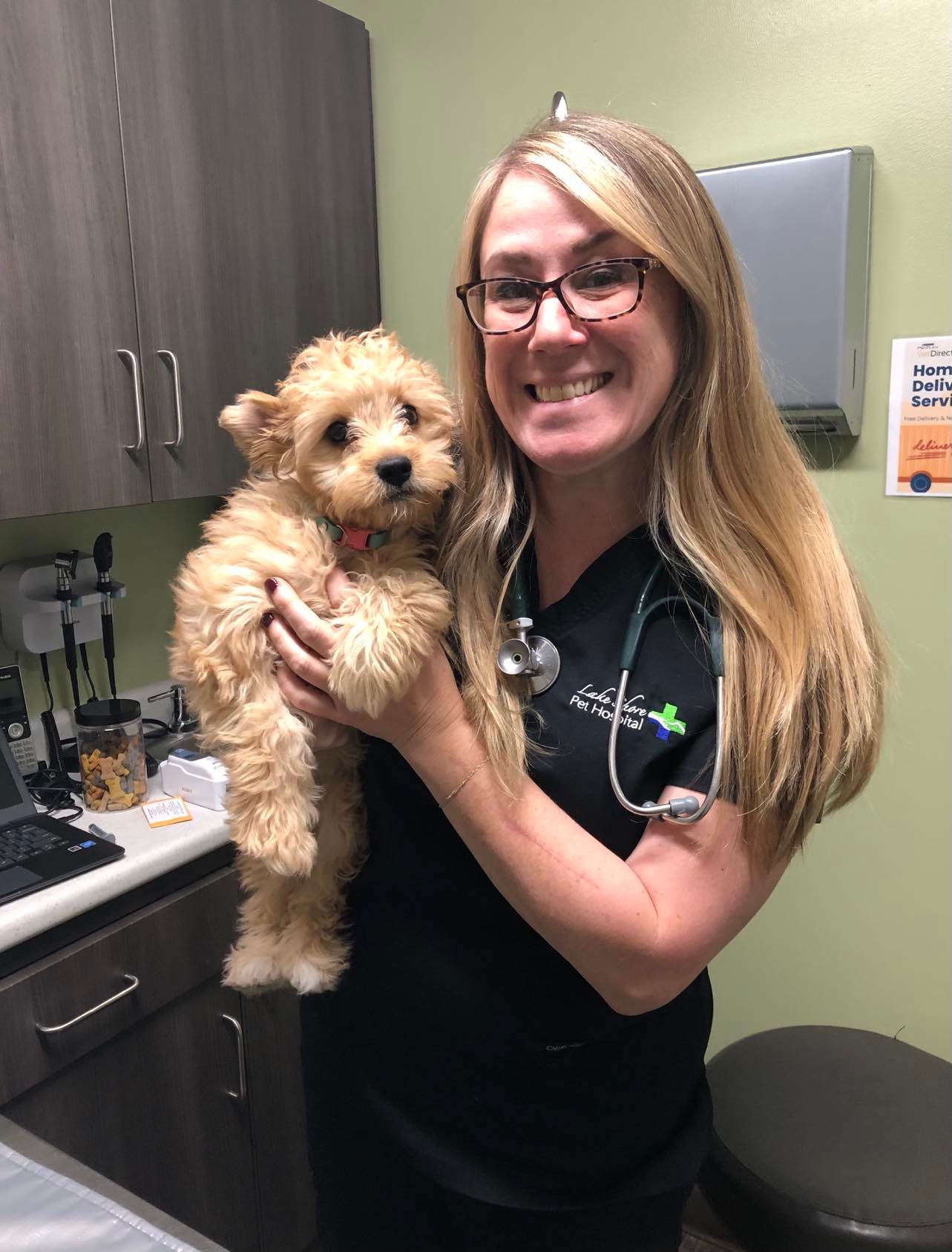
Dr. Cheryl Stiehl hard at work in her veterinary practice.
Dr. Cheryl Stiehl, DVM joins host Laura Reeves to discuss the journey that brought her to the pinnacle of the Owner Handled Series with her breeder-owner-handled Irish Setter.
Stiehl and Declan, GCHS Bramblebush Piper At The Gates Of Dawn, topped more than 825 entries in the National Owner Handled Series finals in Orlando, FL in December.
A practicing veterinarian in Maryland, Stiehl offers her life hacks for succeeding as an owner handler while working a full-time job. And she shares the love — of her dog and the sport.
“I think one of the neatest things about this dog is who he is,” Stiehl said. “His nickname is ‘The Dude.’ He’s just good for purebred dogs, if you know what I mean. He’s funny and ridiculous and silly and he loves kids and loves cats and thinks everything’s an adventure. Declan has friends and friends he has not met yet. That’s just kind of who he is. He’s a bit of a party animal. The other thing and the way I describe him when people say, ‘well, what’s an Irish Setter like, what’s this dog like?’ I say, you know the guy at the tailgate pouring shots? That’s Declan.
“I think that owner handled for me is that there was one more thing I could do with my dog. I can walk in this ring and that ring, I can do it twice. If I get nervous, I can try to work through it.
“I can take out a spleen in the OR with an animal that has a really potentially dangerous or scary prognosis and barely break a sweat. But you know, sometimes I think we all get nervous. Is the dog going to behave? Is he stacked right? Does he look OK? Am I giving him his due?
“On the other side of it too, I think the interesting part of it is your dog’s doing double duty and your dog’s going into that group ring and hopefully going into another best in show ring. So, if you were lucky to win both breed and best of breed owner handled that day, you show your dog a whole bunch and your dog has to perform a whole lot more really. I’ve actually had a few judges say that to me. You know, ‘I watched your dog today and you didn’t give up once.’ So, he is a piece of work. He’s the dude.
“The (NOHS) competition is keen. The dogs are beautiful. They are multiple best in show dogs. They are best in show dogs, they are reserve best in show dogs. They’re group placers, group and specialty winners, sires and dams of beautiful animals. These dogs are worthy. I think that one nice thing is, is it’s the connections you make. I also will say to you that I love the sportsmanship that I have experienced in those ranks. We are really happy for one another.”
Listen to the full episode for more of Stiehl’s insights on the NOHS, dog shows in general, her favorite grooming products and more.
563 – New Tufts University Course: Breeders Teaching Veterinary Students
New Tufts University Course: Breeders Teaching Veterinary Students
Gale Golden and Susan Patterson join host Laura Reeves for a conversation about the new and exciting AKC Tufts Whelping Program that provides information to veterinary students about dog breeders.
Golden, the AKC coordinator for the program, said that the growing difficulties with finding breeder-friendly veterinarians was a huge concern for her.
“As breeders, we’ve faced many challenges and still face many challenges continuing our right to breed dogs here in the United States,” Golden said. “And one of the biggest challenges has been not only the lack of veterinary care, but the lack of understanding of the purebred, responsible dog breeder and how we work and operate. And that has led to, in some instances, lesser care breeders have available to them or even, in emergency situations, outcomes that weren’t the desired outcomes.”
Change the Conversation
Patterson, who has worked with a similar program at the Ohio State University, noted that “we need to change the conversation at the vet school level. How do we show that students, who most likely have never whelped a litter, will never do anything but triage, what a responsible breeder does, what their parameters are, how they make their choices, and how do they whelp their puppies.
“So, we are going directly to the students, who have some pre-formed opinions, but they have no experience. And we are sharing super transparently all the good, the bad, the ugly. We’ve worked with (the staff advisor) to develop what they call a selective, which in normal academic terms would be called an elective. They get to choose. And so, this last semester we had three students, this semester will have five.
“The other thing we’ve done that I think has added tremendously is we’ve not just focused on these students, but we have opened up our monthly roundtables to all interested vet students and we have brought in veterinarians. We had them in the classroom and we did have a virtual crop and dock just because of timing.
Talk About the Hard Things
“So, we’ve addressed the hard things. We’ve talked about what it takes to produce a puppy that is going to be healthy. And why we do the testing, why we make the choices, why temperament and different breeds. And so they’ve been able to ask us really hard questions. And I think the interaction has been very positive.”
“The total lack of understanding of what a purebred dog was and how they came to be and why they came to be” was an “aha” moment for Golden. She noted that one of the important topics covered in the course is the breed standard. “What is the breed standard and how did it come to be. The fact that they didn’t know was a real aha for me.
“The other thing I don’t feel like they really understood was how we preserve a breed. And as I’m sure most everyone here knows, French Bulldogs have been just bombarded with every kind of influence from outside the breed gene pool there could be. And it’s like a breed being attacked on steroids, you know, from fluffy to pink. It all exists. One of the scary statistics for this breed is last year there were 32,000 Frenchie litters registered with the AKC. 294 were parent club members, 294 out of 32,000. And since DNA really can’t accurately show us exactly what’s behind a dog, after a few generations of breeding to Frenchies, it looks like it’s a purebred Frenchie.
“Another aha for me was the health testing process, the Orthopedic Foundation for Animals, that it exists. What kind of data was there, who loads that data and that it is a partnership with veterinarians and breeders that actually populates that database and how we use it to make improvements. So those things were major ahas for me.
“The preservation message, however, is one that resonates for us. We don’t tell our own story. You know, we’re kind of invisible. There might be 90,000 of us in Massachusetts playing dog sports, but I find out legislatively many times we’re invisible. You know, the fact that we let other people tell our story is a problem.”
562 – Applied Structure and Anatomy LIVE in Utah
Applied Structure and Anatomy LIVE
Join the live studio audience with host Laura Reeves at Bonneville Basin Kennel Association to discuss why our dogs are built the way they’re built. Laura and members of the audience address structure and why our dogs are built the way they’re built.
Form and Function go together
There are a lot of differences between herding dogs, depending on the type of herding they did, according to AKC judge and Pumi breeder Chris Levy.
Tonia Holibaugh Cruz
A lot of people think “oh it’s a toy dog, structure doesn’t matter.” What happens is that as companions, these dogs need to be able to live to 10 or 11 years old and still be able to make it to the food bowl. Your expectations of a Pekingese cannot be the same as your expectations of an Italian Greyhound. Even though they’re all toy breeds, their purpose is completely different. The construction is different, therefore their abilities (are different.)
Linda Culver
A properly constructed Italian Greyhound can be just as sturdy as a Whippet
Carma Ewer
I love to see a beautiful schnauzer moving around the ring with great reach and drive, but you don’t have to have great reach and drive to kill a rate. We are starting to lose some of our other qualities. We have to have strong teeth, muzzle and head to be able to do the job. You need to have good bone, muscle tone, don’t want the rat pulling your dog in the hole because it’s so weedy.
Lydia Hovanski Lyon
Tail placement on these terriers is so important. My Fox Terrier, when it goes to ground, and it’s pulling out a fox, I have to be able to grab it by the tail and pull it out, to help it. If we can’t grab onto those tails, that dog is useless and going to die. With the dogs that are going to ground, it is essential to pick them up by their tail. It’s showing they can do the job.
Hear more on this topic when host Laura Reeves presents on Form and Function at Breedercon this weekend at the IKC show in Schaumburg, IL. Sign up for the seminars HERE.
561 – 4Ever15: Choose Kindness
4Ever15: Choose Kindness
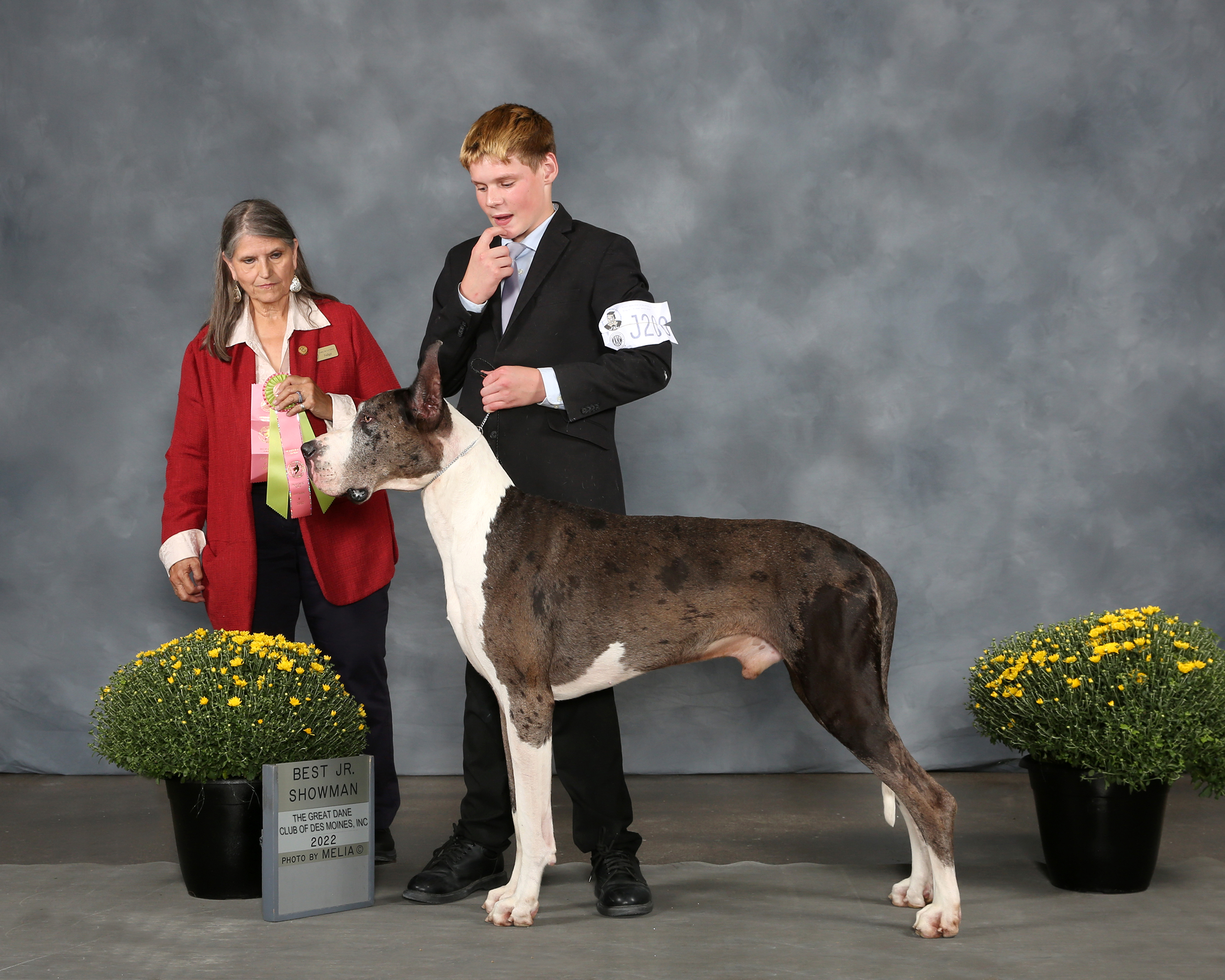
Nick Carroll winning Best Junior Handler at the Great Dane specialty in Des Moines, IA.
Denise Carroll joins host Laura Reeves to share her story of how the twin epidemics of school bullying and teen suicide affected her, after her son, Nick, took his life last month.
Nick Carroll was Denise’s adopted son whose happiest place was dog shows. He had friends and projects and felt safe, showing Great Danes in the breed ring and Juniors.
“It didn’t matter who was competing,” Denise said. “He would cheer you on no matter what. If he lost in juniors he’d still cheer on his friends. The friendships he made at dog shows were really close ones. He maintained some really good friendships.”
But his school life was another matter. Denise said that Nick was routinely bullied at school, including additional attacks around his service dog.
- The 2019 School Crime Supplement to the National Crime Victimization Survey (National Center for Education Statistics and Bureau of Justice) indicates that, nationwide, about 22% of students ages 12–18 experienced bullying.
“What I feel is, when Nick started taking the dog to school is what made him an easy target. School was the biggest issue for him,” Denise said.
How to avoid costing someone their life
“The biggest thing is to realize what we’re all struggling with something,” Denise said. “You never know what someone is going through at the time. So, you should try to be kind. In today’s society, people can hide behind their phone, be anonymous and say things and not have consequences for their actions.”
More survival tips from Denise:
- Today’s kids have gone through a lot more trauma than kids did when I was growing up.
- Walk a mile in someone else’s shoes
- Parents need to talk to their kids, that a difference in someone else isn’t a bad thing
- Parents don’t communicate with kids. Kids have electronics that are their parents. They don’t talk with mom and dad or sit down and have meals together.
Statistics from the Suicide & Crisis Center of North Texas:
-
Suicide is the third leading cause of death of young people between the ages of 15 and 24.
-
5,000 young people complete suicide in the U.S. each year.
-
Each year, there are approximately 10 youth suicides for every 100,000 youth.
-
Each day, there are approximately 12 youth suicides.
-
Every 2 hours and 11 minutes, a person under the age of 25 completes suicide.
-
In the past 60 years, the suicide rate has quadrupled for males 15 to 24 years old, and has doubled for females of the same age.
-
For every completed suicide by youth, it is estimated that 100 to 200 attempts are made.
“We went to Orlando (for the AKC National Championship),” Denise said. “It was bittersweet because Nick was supposed to be with us. I took some friends of Nick’s and his sister to Sea World. We’d laugh for a while and somebody would say Nick would have loved this. At one point, the four of us just hugged each other and cried. It was special because they loved him just like we did.
“Christmas has been hard,” Denise said. “I put off wrapping presents because I had presents for him that he’ll never open….”
Nick’s Message:
Be helpful and kind.
“His shining moments were when he was helping people,” Denise said. “I want more people to be like that. To give to others. And not be takers and just do what’s best for you. We could all take a page from Nick’s playbook.”
To offer condolences or support, contact Denise directly.
560 — Lessons from Orlando and Holiday Musings
Lessons from Orlando and Holiday Musings
The extravaganza of purebred dogs that is the AKC National Championship week in Orlando has come to a close. I skipped the last couple years with the pandemic and all that entailed, so it was really good to be back with the people I so rarely get to see.
I think we all learn something new each time… Like how it’s possible to walk 10 miles and never see the sky…. Or just how many shiny suits St. Johns actually makes…. Or what we jokingly refer to as “snacks in Orlando” … where a cheeseburger, an appetizer and two drinks costs $100….
But there are some actually useful lessons to be learned, some that happened to friends, some observed, some that have happened to me over the years, so here we go.
Wait, my dog is HIGH?
First up, dogs put ridiculous things in their mouths. Even at high-end hotels, be observant and careful when letting your dog roam free in the room. My friend Ingrid learned this lesson the very hard way this week when her Chihuahua found and ingested marijuana in a hotel room on her trip to Orlando. She is now extremely aware of the signs of cannabis toxicity in dogs….
This has become something of an epidemic at veterinary practices, according to Dr. Marty Greer. So, for those who haven’t experienced this, here are some tips. Also, take a listen to our past podcast on the topic of how cannabis can be useful in treating dogs in forms that do not contain THC.
Cannabis contains more than 100 different chemicals (or compounds) called cannabinoids. Tetrahydrocannabinol (THC) is the cannabinoid that has the most psychoactive effects. It is also the compound responsible for some of cannabis’ medicinal uses, such as treating nausea and improving appetite in cancer patients. Other compounds, such as cannabidiol (CBD), have shown promise for medicinal use and do not have psychoactive effects.
Dogs have more cannabinoid receptors in their brains, which means the effects of cannabis are more dramatic and potentially more toxic when compared to humans. A small amount of cannabis is all it takes to cause toxicity in cats and dogs.
Per VCA Animal Hospital, most of the signs of intoxication are neurological. Pets may become wobbly and uncoordinated. They may be hyperactive or sleepy, disoriented, and/or very vocal. Their pupils may dilate, giving them a wild-eyed appearance, and they may drool excessively or vomit. They may also develop urinary incontinence (i.e., urine leakage). In severe cases, tremors, seizures, and coma can result.
Physical signs include slow or fast heart rate, altered blood pressure, and slowed respiration rate (breathing rate). Lethargy and increases or decreases in body temperature may also be observed. Fortunately, these side effects are usually short-lived but they can still be dangerous and make your pet quite miserable.
Diagnosis is based on an accurate history and clinical signs. Although there are tests to determine the level of THC in the urine, the results take time, making them impractical. Human urine drug screening tests are quicker but are not dependable in pets. The diagnosis is made much more quickly, and treatment initiated, when responsible pet owners provide accurate information regarding the pet’s exposure.
When a toxin enters the body, often the first line of defense is to get it out. If the toxicity is discovered shortly after ingestion, your veterinarian may induce vomiting to prevent further absorption of the toxin.
Two factors may interfere with this early defensive strategy. First, the signs of toxicity may manifest only after the drug has been absorbed, meaning it is already in the system. Second, cannabis has an anti-emetic effect that inhibits vomiting. In life-threatening cases, the stomach may be pumped (gastric lavage). Activated charcoal may be administered every six to eight hours to neutralize the toxin. Enemas are also used to reduce toxin absorption from the gastrointestinal tract.
The second line of defense in cannabis toxicity involves providing supportive care until the effects of the drug wear off. Medications and supportive care to regulate your pet’s heart rate, respiration, and body temperature are used if needed. Since your pet may be lethargic, with no desire to eat or drink, IV fluids can help prevent dehydration, support blood pressure, and maintain organ function. Anti-anxiety medications can minimize agitation. Gastrointestinal treatments may be needed for nausea or vomiting. To prevent self-trauma while your pet is disoriented and uncoordinated, confinement in a safe, comfortable space is helpful. Noise should be kept to a minimum to decrease sensory stimulation.
If cannabis is ingested with toxic or problematic substances, such as xylitol, chocolate, raisins, or foods containing a lot of fat, supportive care or additional treatments may be required to treat conditions associated with the ingestion of those substances.
Pro Tip
Next, carpets are slippery! The AKC National Championship show, Westminster Kennel Club, and many of the biggest shows in the country feature beautifully carpeted rings to showcase the dogs. Experienced exhibitors know that dogs don’t move well on the carpet because their feet slip and they can’t drive off their rears. Even in a stack, dogs can have trouble holding their normal position. The best solution to this problem is to keep the dog’s feet wet. Spray bottles of water or wet towels will soften the hard pads enough to give the dog a grip on the carpet. This will allow you to showcase your dog to its best advantage on that gorgeous red carpet.
Your feet also need some consideration…. We’re putting in LOTS of hours on our feet… moving, standing, running, walking. Your entire body depends on those feet, so take care of them. Change shoes midday. Just the slightest shift in fit makes an enormous difference. I’m given rations of grief about my “shoe suitcase” but I promise, if I had taken better care of my feet when I was younger, it’s a good bet I’d live with less pain today…
Third, we would all do well to learn lessons from the best junior handlers in the country. They are supportive and outstanding sports, they cheer for each other, they encourage each other, they tease friends through bouts of nerves. They are composed under immense pressure, they are driven to succeed, they ooze talent and dedication. They may or may not be the future of the sport, but *their* futures will be immensely improved by the lessons they take away from the sport and incorporate in their daily lives.
We hear an awful lot about millennial this or teenage entitlement that, but when you see these young men and women working their butts off, sprinting over miles of concrete, competing at the highest level and often working ridiculous hours for handlers to support their dreams, you are left with a much different understanding of our youth. The best and brightest of these kids will shine no matter where their life’s journeys lead them.
Redemption is a Thing
Winston Churchill’s oft repeated quote is more fitting to our sport than most…
“Success is not final; failure is not fatal: it is the courage to continue that counts.”
Watching friends battle back from injuries, defeats, disappointments and setbacks has been inspiring for me, particularly this year. Kelly Shupp, who just handled our Spinone to win the Sporting group here, shattered her ankle in September and we really didn’t think she’d even be walking by this time. She fought through pain and frustration and disappointment and dedicated herself to being on the end of Josie’s leash to wrap up what had been a history making year already. Her strength and determination and sheer will power literally bring me to tears of awe.
Sharing is Caring
Whether it’s the YaYa Sisterhood of the traveling outfits when you win the group and didn’t expect to or a corner of a grooming space in a crowded building, this sport really can bring out the best in us. I treasure the people and friendships built over my lifetime in this sport.
I know there are Debbie downers out there, but I firmly believe that our lives are immeasurably richer when we focus on the positive and find the beauty around us. It’s lots easier to do that if you simply avoid and/or ignore the folks who would burst that bubble.
Big Trips are Exhausting
Having driven cross country innumerable times, in various vehicles, daunting weather and impossible schedules, I offer a few words of wisdom.
- Plan ahead. If something can go wrong, it will and at the most inconvenient time. Have backup plans for your backup plans. Pay attention to the weather apps. I used weather underground to route around upcoming storms. Adding an extra few hours or even a day to the trip to travel safely saved me countless headaches. Factor that into your planning. If you don’t need the extra day to arrive safely, you can always use it to relax and have a little fun on the journey.
- Sleep more and eat less. I always stop for a good night’s sleep. I need it to be safe on the road. And the dogs sleep better when the rig isn’t moving. I snack a lot when driving but rarely eat huge meals. I also stop every three to four hours to x dogs, get fuel, walk a little, stretch and keep the blood moving.
- Listen to a podcast! Lol
Thank YOU…
In closing, as we end the year of competition and transition into the holidays, I wanted to take this opportunity to thank you guys. It’s been 6 years now of talking to y’all. I was stopped this week by a lovely young man with a Barbet. He shared with me that the whole reason he was at the show was because of the work we do here. That he’d discovered the breed because of our episode with Judy Descutner. That the podcast gave him the tools and encouragement to stick with it. That brief conversation was the best gift ever.
And it’s those stories, YOUR stories, that keep me keepin’ on. So, thank you for taking us along …. On your road trips, your workouts, your grooming sessions, and your lawn mowing. I’m looking forward to a whole new year of sharing fabulous stories with you.
And I hope you’ll join us on the first Tuesday of every month for the live podcasts on the Facebook page, LIVE@5. If you haven’t had a chance, stop by Pure Dog Talk and join our Patrons getting their Pure Pep Talks.
559 – Food Fight? Science Based Facts on Feeding Your Dog
Food Fight? Science Based Facts on Feeding Your Dog
Rob Downey, President and CEO of Annamaet, foundational researcher in pet feeding, joins host Laura Reeves to discuss the pros and cons of raw vs kibble and how to make sure your pet is fed a healthy diet.
“The real thing is, with any product, is how well it’s balanced and the raw materials going in to it,” Downey said. “You can’t say all raw is better or all kibble is better. It really comes down to the formulation. Whether or not its AFCO approved, who’s done the testing and the raw materials that are included.
“I’ve studied nutrition for close to 40 years. When we put together our products, not only was I there, we had a board certified veterinary nutritionist and a guy who got his PhD in vitamins. The three of us hammered this out for weeks. It just amazes me that somebody thinks I’ll just put this together in my back yard and I’ll add some green beans and everything will be good.
“It’s especially a concern right now when studies have shown how important vitamins and minerals are.
“The problem is (vitamin deficiencies) are happening sub-clinically. Studies have shown that 60 percent of home prepared diet are deficient of at least one nutrient.
“Most veterinarians aren’t really trained in nutrition. Only about 50 percent of veterinary teaching universities even have a core nutrition course. Veterinarians have to learn so much, they just don’t have time.
“One of the things when you’re talking raw or home-prepared diets, you want to be careful you don’t go over about 10-15 percent organ meat. Organ meat tends to be really high in Vitamin A and copper. Copper storage disease is a rising threat in many breeds not predisposed to it….. Copper is stored in the body in the liver.
“I don’t care if it’s raw or kibble, if you start with the wrong raw materials, you can have trouble. To say one is better than the other is difficult.
“People are loyal to raw because so many people want to feed their dogs like wolves… Wolves only ate every three to five days and had to chase down their prey… Dogs have evolved. Dogs were domesticated before any other animal or crop. The ability to break down carbohydrates is through the amylase genes. Dogs have evolved to the point that they have seven times more amylase genes than wolves.”
From the Study:
“A recent comparison of genome-wide patterns of genetic variation in a large panel of dogs and wolves identified genomic regions that were affected by directional selection during early dog domestication “(Axelsson et al. 2013). Through functional characterization of genes residing in these domestication regions, new light was shed on characteristics of adaptive advantage to early dogs. These analyses identified several genes involved in digestion and energy metabolism, suggesting that the transition from wolf to dog was accompanied by a change in diet. Augmented by evidence from expression analyses and enzyme assays, it was concluded that changes in three consecutive steps in the pathway responsible for starch digestion and subsequent glucose absorption allowed dogs to rely on a diet rich in starch relative to the carnivorous wolf diet (Axelsson et al. 2013).”
Find the entire study HERE.
558 — Holiday Gift Guide, SuperZoo and Small Business Saturday
Holiday Gift Guide, SuperZoo, and Small Business Saturday
Dr. Marty Greer, DVM, and host Laura Reeves throw out some GREAT ideas for holiday gift-giving for the animal-loving family. Greer’s recent trip to SuperZoo and strong support for Small Business Saturday provide heavy influence on the list!
Find links below to many of the products mentioned on the podcast and more.
Small Business Saturday
- Gift certificate for your vet
- Gift certificate for your groomer
- Tips for the groomers
- Goodies for your veterinary clinic – remember them when it ISN’T a holiday!
- NAIA Giving Tuesday
- Gift certificate for freezing and storing semen
- Gift a Pure Dog Talk Patrons Membership for a friend or puppy buyer
APPLE AIRTAGS – WITH CASES FOR DOGS – chose a waterproof case that is durable. These are not meant to be dog-tracking devices – they are for luggage and backpacks
557 – From Chasing to Pacing: Troubleshooting In-Ring Movement Issues
From Chasing to Pacing: Troubleshooting In Ring Movement Issues
Laura’s monthly LIVE@5 podcasts offer an interactive opportunity for listeners to ask questions and get personal insight. This particular topic revolved around questions regarding movement. Laura provides techniques to deal with dogs that pull, lunge, lack focus or pace in the ring.
Q: (My dog) has this new thing where, on the go round, he pulls very hard toward the center of the ring and starts to gallop.
A: Our dogs don’t communicate with us, and we don’t communicate with them, with our words. What they hear is our tone of voice. Our body language and our energy. So, like our nervous energy, or our negative energy, or our very positive energy, or most importantly our Zen.
If the situation happens when going around with a group of dogs, instead of standing there facing the back end of those dogs as they start to run away, I turn the dog. I put him fully perpendicular to that line of dogs running away. I keep him completely focused on me and on a watch me until it is our time to go. We give the dog in front of us three full strides before I start. And then we go and then the dog is going to be more collected, more together.
Q: When gaiting, (my dog) always wants to be looking at me instead of straight ahead where we’re going, which I feel throws off his gait.
A: Don’t look at the dog. It seems kind of silly and sort of simple, but we get so worried about what the dog is doing that we’re constantly looking at them. And the dog’s reaction of course because again, they don’t respond to words, they respond to body language. If we’re giving them eye contact, they’re going to give it back.
Laura covers everything from chasing to pacing in this great interactive conversation.
Don’t forget to check out the next LIVE@5 on the first Tuesday of every month.


